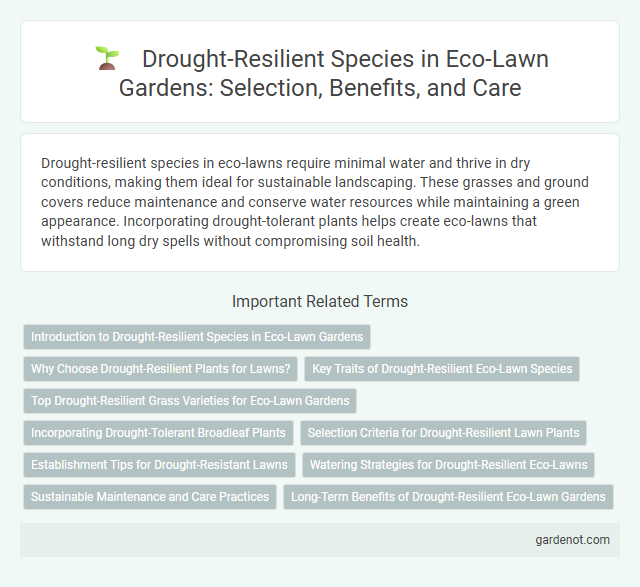Drought-resilient species in eco-lawns require minimal water and thrive in dry conditions, making them ideal for sustainable landscaping. These grasses and ground covers reduce maintenance and conserve water resources while maintaining a green appearance. Incorporating drought-tolerant plants helps create eco-lawns that withstand long dry spells without compromising soil health.
Introduction to Drought-Resilient Species in Eco-Lawn Gardens
Drought-resilient species in eco-lawn gardens are plants specifically adapted to thrive with minimal water, reducing irrigation needs and promoting sustainable landscaping. These species, such as buffalo grass, blue grama, and fescues, have deep root systems and efficient water usage, making them ideal for arid climates and water-restricted areas. Incorporating drought-resilient plants in eco-lawns enhances soil health, conserves water resources, and supports biodiversity through native and climate-appropriate vegetation.
Why Choose Drought-Resilient Plants for Lawns?
Drought-resilient species in eco-lawns reduce water consumption by thriving with minimal irrigation, significantly lowering maintenance costs and environmental impact. These plants enhance soil health through deep root systems that improve water retention and nutrient cycling. Selecting drought-tolerant grasses and groundcovers ensures sustainable lawn management amid increasing climate variability and water restrictions.
Key Traits of Drought-Resilient Eco-Lawn Species
Drought-resilient eco-lawn species exhibit deep root systems, enabling efficient water absorption and retention during extended dry periods. These species often possess waxy or hairy leaf surfaces that reduce water loss through transpiration, ensuring sustained green coverage. Their ability to enter dormancy and quickly recover after rainfall underscores their adaptation to arid environments, making them ideal for sustainable, low-water-use landscaping.
Top Drought-Resilient Grass Varieties for Eco-Lawn Gardens
Bermuda grass, buffalo grass, and zoysia grass rank among the top drought-resilient species ideal for eco-lawn gardens due to their deep root systems and low water requirements. Fine fescues and blue grama grass also excel in drought tolerance, maintaining green coverage with minimal irrigation. These grass varieties support sustainable landscaping by reducing water consumption and enhancing soil health in arid and semi-arid regions.
Incorporating Drought-Tolerant Broadleaf Plants
Drought-resilient eco-lawns benefit significantly from incorporating drought-tolerant broadleaf plants such as buffalo grass, clover, and yarrow, which enhance soil moisture retention and reduce irrigation needs. These broadleaf species improve biodiversity, support pollinators, and maintain vibrant green coverage under prolonged dry conditions. Integrating deep-rooted, drought-adaptive plants into eco-lawns creates sustainable landscapes that conserve water while promoting ecosystem health.
Selection Criteria for Drought-Resilient Lawn Plants
Selection criteria for drought-resilient lawn plants prioritize species with deep root systems, such as buffalo grass and native fescues, which efficiently access soil moisture during dry periods. Adaptations like efficient water-use photosynthesis (C4 or CAM pathways) and thick, waxy cuticles enhance drought tolerance and reduce evapotranspiration. Choosing grasses with proven resilience in arid climates supports eco-lawns that maintain green coverage while minimizing irrigation needs.
Establishment Tips for Drought-Resistant Lawns
Drought-resilient species such as Bermuda grass, buffalo grass, and zoysia grass thrive in eco-lawns by requiring minimal water once established. To ensure successful establishment, seed or sod should be planted during mild seasons with consistent moisture until roots develop, promoting deep rooting for drought resistance. Regular mowing at higher blade heights and reducing irrigation gradually encourage water conservation and improve overall lawn durability.
Watering Strategies for Drought-Resilient Eco-Lawns
Drought-resilient eco-lawns thrive using deep, infrequent watering to encourage strong root systems, essential for surviving extended dry periods. Utilizing drip irrigation or soaker hoses minimizes water waste by delivering moisture directly to the soil, enhancing efficiency for drought-tolerant species like buffalo grass and blue grama. Monitoring soil moisture levels and adjusting watering based on seasonal rainfall supports eco-friendly water conservation without compromising lawn health.
Sustainable Maintenance and Care Practices
Drought-resilient eco-lawn species such as Buffalo grass, Bermuda grass, and Fine Fescues require minimal watering and adapt well to low-moisture conditions, significantly reducing water consumption. Sustainable maintenance practices include mowing at higher heights to encourage deep root growth and using organic fertilizers to enhance soil health and moisture retention. Implementing drip irrigation and mulching further conserves water while promoting a resilient, eco-friendly lawn ecosystem.
Long-Term Benefits of Drought-Resilient Eco-Lawn Gardens
Drought-resilient eco-lawn gardens utilize native grasses such as buffalo grass and blue grama, which require significantly less water than traditional lawn species, promoting sustainable water conservation. These species enhance soil health by reducing erosion and improving moisture retention, resulting in lower maintenance costs over time. Long-term benefits include increased biodiversity, reduced carbon emissions, and resilience to extreme weather conditions, making eco-lawns an environmentally and economically advantageous choice.
Drought-resilient species Infographic

 gardenot.com
gardenot.com